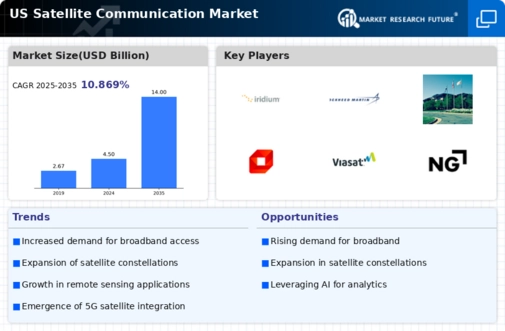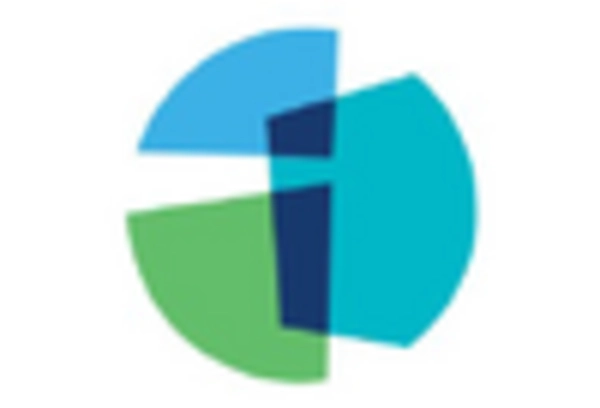The satellite communication market is currently characterized by a dynamic competitive landscape, driven by technological advancements and increasing demand for connectivity across various sectors. Key players such as SpaceX (US), Intelsat (US), and Iridium Communications Inc. (US) are strategically positioning themselves to leverage innovations in satellite technology and expand their service offerings. SpaceX (US), for instance, focuses on its Starlink project, which aims to provide high-speed internet globally, thereby enhancing its competitive edge through a robust low Earth orbit (LEO) satellite constellation. Meanwhile, Intelsat (US) emphasizes partnerships and collaborations to enhance its service capabilities, particularly in the enterprise and government sectors, indicating a trend towards strategic alliances that bolster market presence.
The business tactics employed by these companies reflect a moderately fragmented market structure, where localized manufacturing and supply chain optimization are becoming increasingly vital. Companies are investing in regional facilities to reduce operational costs and improve service delivery. This competitive structure allows for a diverse range of offerings, with key players influencing market dynamics through their unique strategies and operational focuses.
In October 2025, SpaceX (US) announced the successful launch of its latest batch of Starlink satellites, which is expected to enhance global internet coverage significantly. This strategic move not only reinforces SpaceX's commitment to expanding its satellite network but also positions the company as a leader in the broadband market, potentially increasing its subscriber base and revenue streams. The implications of this launch are profound, as it may lead to increased competition in the broadband sector, compelling other players to innovate and enhance their service offerings.
In September 2025, Intelsat (US) entered into a partnership with a major telecommunications provider to enhance its satellite-based broadband services. This collaboration aims to leverage both companies' strengths, thereby expanding Intelsat's reach in underserved markets. The strategic importance of this partnership lies in its potential to drive growth in regions where traditional internet infrastructure is lacking, thus positioning Intelsat as a key player in bridging the digital divide.
In August 2025, Iridium Communications Inc. (US) launched its new satellite communication service tailored for the maritime industry. This service is designed to provide reliable connectivity for vessels operating in remote areas, highlighting Iridium's focus on niche markets. The launch signifies a strategic pivot towards specialized services, which may enhance customer loyalty and open new revenue channels in a competitive landscape.
As of November 2025, the satellite communication market is witnessing trends such as digitalization, sustainability, and the integration of artificial intelligence (AI) into service offerings. Strategic alliances are increasingly shaping the competitive landscape, as companies recognize the value of collaboration in enhancing technological capabilities and market reach. Looking ahead, competitive differentiation is likely to evolve, with a shift from price-based competition to a focus on innovation, technology, and supply chain reliability. This transition suggests that companies that prioritize these aspects will be better positioned to thrive in an increasingly complex market.

















Leave a Comment